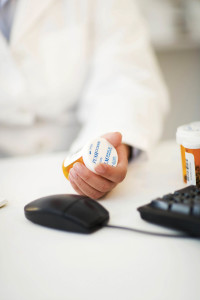Promising pharmacy programs reduce readmissions and adverse drug reactions and help monitor patients more efficiently
As healthcare facilities increasingly focus on reducing readmissions, medication therapy management (MTM) programs are emerging as a potent force to achieve that goal and improve the continuum of care.
Nearly 20 percent of Medicare patients discharged from hospitals are readmitted within 30 days, and medication-related adverse events cause a significant number of those cases, according to a report from the national health policy institute NEHI.
“Medication management is at the core of advanced discharge planning and transitional care,” the report stated. “This reflects three realities: Adverse events are a major cause of avoidable hospital readmissions; more post-discharge adverse events are related to drugs than other causes; and lack of adherence to medications prescribed at discharge has been shown to be a driver of post-discharge adverse drug events.”
Research indicates that MTM programs can help reduce readmissions. For example, a recent study led by Purdue University found that low-risk Medicare patients who received MTM services by phone after discharge were three times less likely to be hospitalized within the next 60 days. The process did not reduce readmissions for higher-risk patients, suggesting that more intensive measures might be required for such a group.
The American Pharmacists Association (APhA) defines medication therapy management as “a service or group of services that optimize therapeutic outcomes for individual patients” in both inpatient and outpatient settings. MTM programs are based on close collaboration between providers and pharmacists and can include medication therapy reviews, pharmacotherapy consults, anticoagulation management, immunizations, health and wellness programs, antimicrobial stewardship, and other clinical services.
In general, pharmacists assess patients’ medications and conditions in both inpatient and outpatient settings to make sure they get the most benefit from their prescribed drugs. They look for untreated conditions, drug interactions, adverse drug reactions, inappropriate drugs or doses, and whether patients are taking the medications as prescribed.
New MTM programs are going live every day as healthcare administrators seek the best approach for their facilities and communities. Personnel at several HealthTrust member hospitals—Columbus Regional Health, HCA, University of South Alabama Health System, St. Joseph Medical Center/Franciscan Health System and Porter Adventist Hospital—shared their MTM experiences.
Columbus Regional Health (CRH), Columbus, Georgia
Comprising several hospitals as well as outpatient clinics, Columbus Regional Health is a community-based teaching hospital that has its own pharmacy residency program and is affiliated with pharmacy programs at the University of Georgia, Auburn University and Mercer University.
As a result, CRH has board-certified PharmDs, residents, students and technicians to staff its inpatient and outpatient MTM programs, explains Burnis D. Breland, M.S., PharmD, FASHP, director of pharmacy.
“Managing medication therapy at bedside is something we take pride in,” Breland says. “It’s a service available to all patients at all times.”
“Managing medication therapy at bedside is something we take pride in. It’s a service available to all patients at all times.”
—Burnis Breland, M.S., PharmD, FASHP, director of pharmacy, Columbus Regional Hospital
The inpatient program is staffed 24/7 with pharmacists on patient floors. During the day, pharmacists also are available in specialty areas such as neonatology and ICU. Pharmacists, residents and students round with physicians and collaborate closely on medication orders and changes. Technicians frequently assist in non-decision-making matters and also aid physicians with order entry, says Breland, who has 30 years’ experience in pharmacy.
The inpatient and outpatient programs evolved over time and are constantly being refined based on experience.
“We were an early leader in this level of care, and other hospitals are moving toward it,” says Breland, who in 2010 authored the Georgia law that permits such collaboration between physicians and pharmacists.
Technology plays a strong supporting role in MTM, including the Siemens Soarian healthcare process management solution and Med Administration Check (MAK) barcoding system, and the McKesson Robot Rx system. But it’s the dedication of staff to the program that has made it so successful.
CRH uses a number of metrics to track the performance of its MTM program. For example, compliance with guidelines for restricted antibiotics hovers at 98 percent, and adherence to anticoagulant therapy is at 100 percent, Breland says.
Hospital Corporation of America (HCA)
After a successful six-month pilot program last year at its Presbyterian/St. Luke’s Medical Center in Denver, Colorado, HCA in late May rolled out a pharmacy surveillance software tool at 37 more facilities, says Hayley Burgess, PharmD, director of Medication Safety and System Innovations, Clinical Services Group.
The nearly real-time system is designed to fit into pharmacists’ workflow and helps them more quickly and thoroughly evaluate and monitor medications. The software compares patient records and pharmacy orders against about 1,200 “rules” to determine if the prescription is appropriate and to prevent problems such as potential adverse reactions.
“Medication management today is so incredibly complex … [HCA’s pharmacy surveillance software] tool is a safety net for the pharmacy, the physician and the patient. It helps ensure comprehensive patient care.”
— Hayley Burgess, PharmD, director of Medication Safety and System Innovations, Clinical Services Group, HCA
“Medication management today is so incredibly complex; no one can remember every aspect about every medication,” Burgess says. “The tool is a safety net for the pharmacy, the physician and the patient. It helps ensure comprehensive patient care.
“The tool does not remove clinical judgment—it’s a backup that double-checks that the right medications were ordered, and it has triggers to help prevent adverse drug events for patients,” she continues.
The results of the pilot program proved the system’s worth, she says. For example, the number of antimicrobial stewardship interventions rose from 250 per month at the start of the program to an average of 800 to 1,000 per month at its end. And the number of healthcare-related venous thromboembolisms dropped to zero.
“We began preventing problems sooner,” Burgess says.
The pilot program also enjoyed high user satisfaction, she says. Comments include endorsements such as “very easy to use, it has enhanced my ability to optimize medication therapy for patients on my floor”; “it alerted me to lab values and drug problems I may not have been aware of before having the system”; and “it allows me to spend more time on patient care.”
University of South Alabama Health System, Mobile, Alabama
“Every order our pharmacists receive is treated as medication therapy management,” says Steve Bethea, pharmacy director at the University of South Alabama Medical Center. “Our pharmacists round with the medical teams, as do faculty pharmacists and university students.”
Caseworkers advise inpatients that they can consult with pharmacists, “and almost 100 percent opt in,” Bethea says. “Everybody wants to talk to a pharmacist.”
The University of South Alabama Health System includes two hospitals as well as outpatient programs and the private practices of academic physicians affiliated with the College of Medicine.

In addition, the university is involved with a patient care network demonstration project for Medicaid. Covering Mobile and Washington counties in southwest Alabama, the program currently has about 400 patients and employs three pharmacists, as well as social workers and other professionals.
The program is testing whether providing a high level of access to better care can reduce readmission rates for patients who have the 10 most common chronic disease states, such as diabetes, COPD and congestive heart failure, Bethea says.
The pharmacists review patient files, orders for tests and medications, and other records prior to discharge. The goal is to make sure patients have been prescribed the most cost-effective drugs in the Medicaid formulary, in the correct dosages and at the correct frequency of administration.
The pharmacists also ensure patients and/or caregivers understand instructions about medications. Three days post-discharge and as long as necessary thereafter, they follow up with patients to address any concerns.
The university also has added a pharmacist to its emergency department to perform similar functions with non-Medicaid patients, Bethea adds. His team currently is working on metrics to measure this program’s success.
Medication therapy management programs are time- and labor-intensive, Bethea notes. He predicts that as more hospitals launch MTM programs, the demand for pharmacists and pharmacy technicians will soar.
Porter Adventist Hospital, Denver, Colorado
Porter Adventist Hospital recently began soliciting referrals to its new Medication Therapy Management (MTM) Transitions of Care Program, says Susan Tripp, PharmD, CACP, BCACP, clinical pharmacist and head of the Porter Anticoagulation Center.
The program will initially focus mostly on respiratory patients with COPD and pneumonia, who have the second-highest overall risk of readmissions after patients with coronary heart failure (CHF). Porter already had a pharmacist-run discharge consultation process in place for CHF patients, Tripp explains.
“There will be a mix of patients, but our quality department determined the respiratory patients were at greatest risk,” Tripp say. Other high-risk situations include patients who take five or more medications for multiple disease states, and those who have had two or more medication changes while an inpatient, she says.
Funded by a small grant, the project launched in May. Patients who are referred to the program are asked to complete a simple assessment questionnaire prior to the appointment. During their appointment, a pharmacist conducts a medication review and updates their medication list while identifying potential medication-related problems such as drug interactions, adherence, patient concerns and duplicate therapy.
Patients receive a detailed, personalized medication action plan summarizing the results of the visit and giving them tasks to do, such as scheduling an appointment with their primary care provider and pulmonologist and recording peak airflow readings. Their physician also receives a visit summary letter that includes issues identified and recommendations.
Education is a major goal of the MTM program, Tripp says. To help the patients stay on track, the pharmacist gives them a chart listing when to take each medication and cautions, such as “take with food” or “may cause drowsiness.”
St. Joseph Medical Center/Franciscan Health System, Tacoma, Washington
In April 2013, St. Joseph Medical Center began work on its patient-centered medical home model to provide better care by improving coordination across the care continuum, says Eric S. Wymore, PharmD, MBA, regional clinical pharmacy manager of inpatient/ambulatory services, Franciscan Health System.
The health system operates over 30 outpatient clinics. With only two pharmacists available to staff the program at this point, the decision was made to staff the busiest clinic full time with one pharmacist, while the second would spend half days at each of two other clinics.
The program began in the fall of 2013. Initially, the pharmacists handled refill requests. “This was an opportunity to get our foot in the door and help the providers by reviewing patient records and ensuring the refill was appropriate,” says Kristin Peterson, PharmD, BCPS, ambulatory care clinical pharmacy specialist, Franciscan Health System.
If they thought a change in medication might be beneficial, the pharmacists also could recommend that patients visit the clinic. The pharmacists frequently scheduled patients for face-to-face visits either before or after their follow-up physician appointment.
Over time, the pharmacists spent less time on refills and more on consultations, patient interviews and follow-up calls, patient education and administering vaccines, Peterson says.
For example, the pharmacists handled 551 refill requests in October, but only 97 in March 2014. Over the same period, patient calls jumped from 76 to 229, and consults increased from 91 to 165. The pharmacists also tracked outcomes, monitoring patients with conditions such as hypertension, diabetes, hyperlipidemia, coronary artery disease and congestive heart failure.
“The patients who had pharmacy consults did better by every metric we monitored,” says Erik Kellison, PharmD, a PGY1 pharmacy practice resident at St. Joseph Medical Center/Franciscan Health System who completed a longitudinal project evaluating patient outcomes in the program.
One patient was a 60-year-old female taking 10 medications for management of six chronic diseases. She was seeing her physician every two weeks, primarily for management of her uncontrolled hypertension (177/83 mm Hg) and diabetes (A1c at 9.4 percent). Subsequently she was enrolled in the medical home care model, and in three months she received care from a diverse group of medical home providers, including a dietitian/certified diabetes educator, a nephrologist, a nurse and a medical administrator. She also saw her physician once every six weeks and a pharmacist every two weeks. At the end of these three months, her blood pressure was lowered to 112/54 mm Hg, her A1c was down to 7 percent, and her 10-year cardiovascular disease risk score was lowered from 36.9 to 11.2 percent.
While effective, the personalized approach with mostly one-on-one, face-to-face consultations is time-consuming, so adequate staffing is critical, Wymore says. “Having someone explain [medication use] simply is much more effective than reading or looking something up online.”
St. Joseph Medical Center is in the process of expanding its pharmacy services to multiple clinics.
Share Email Medication Therapy Management, Outcomes, Patient Education





